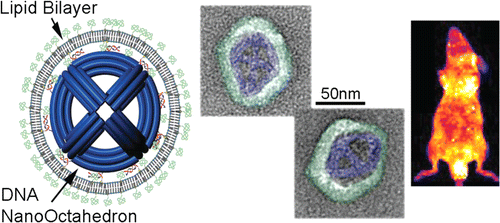It’s not easy to send a micro-machine into a human body. Our immune systems quickly scramble to intercept and destroy microscopic invaders. If we’re going to use micro machines, aka nanostructures, to deliver finely targeted medicines, or to ferret about inside sick bodies for tumors, we need to come up with some kind of a cloaking device—something to simulate in vivo invisibility.
A pair of scientists at Harvard Medical School may have just figured out how to do that.
The duo painstakingly crafted tiny bodily invaders, producing vessels that ferried DNA structures into anesthetized mice. Their cloaking design was inspired by the guileful layers of lipids that surround viral DNA. The scientists describe their devices as “tightly wrapped unilamellar nanostructures” that mimic the “morphology of enveloped virus particles” and could provide a design strategy for biomedical applications.
Virus-inspired devices could be used to deliver medicines to the organs and cells that need them, and programmed to break down when they reach their target.
The DNA structures produced by the scientists were medically useless, but they helped measure the effectiveness of their virus-inspired cloaking devices. They were basically just itty bitty octahedrons, which the scientists called DNA nano-octahedrons, or DNOs. They were designed using cadnano, which is open-source software for making DNA origami, and self-assembled in a reaction that used DNA harvested from bacteria.
When the octahedrons were injected into the mice, they were quickly attacked by the rodents’ immune systems. Imaging systems that the scientists trained on fluorescent nucleic acids inside the DNOs revealed that the octahedrons had average half-lives of about 50 minutes.
By encasing the octahedrons inside virus-inspired lipid envelopes, however, the average half-life was boosted to a little more than six hours.
“In comparison to N[non-enveloped]-DNO, encapsulation increased the elimination half-life and relative bioavailability,” the scientists write in a paper published this month in Environmental Science & Technology. The “virus-inspired E[encapsulated]-DNO displays favorable in vitro and in vivo properties, in stark contrast to non-enveloped DNO which activates a potent immune response and displays rapid degradation after injection.”

(Photo: Environmental Science & Technology)
Virus-inspired devices could be used to deliver medicines to the organs and cells that need them, and programmed to break down when they reach their target. That could be achieved by tweaking the lipid layer. Such devices could also be used in diagnostic explorations, like hunting down tumorous cells.
Perhaps the ancient virus tricks could even be used as defenses against viruses themselves.
“One could imagine ways of treating viral infections with such structures eventually,” says Harvard Medical School Associate Professor William Shih, who partnered with his colleague Steven Perrault on the research. “One could make molecular flypaper that binds and inactivates viruses. Or one could make a vaccine against a virus.”




